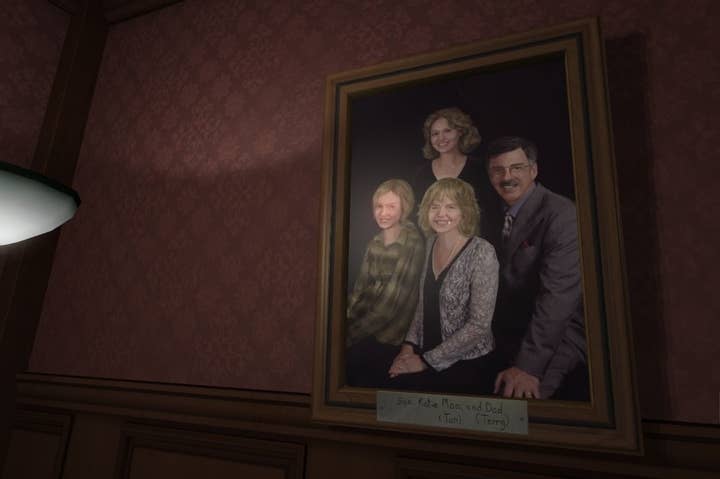Why is Gone Home a game?
Steve Gaynor addresses detractors, explains why his indie hit had to be a video game
While the Fullbright Company's Gone Home has received critical adulation and a trophy case's worth of awards, it has also seen plenty of detractors. Many of those who dismissed the game--in which players explore a vacant home and piece together a narrative from the detritus of everyday life surrounding them--question whether or not it qualifies as a game at all. In a GDC talk this morning, Fullbright co-founder Steve Gaynor used that common criticism as a launching point for his presentation.
Gaynor explained that his background in the industry largely consisted of working on the BioShock series, "capital G Games" with all kinds of violence in them. Gone Home was the first title he worked on that received not just sterling reviews, but also conspiracy theories from players who thought high review scores could only be attributed to shady dealings.
"I hope that Gone Home is very much a game, that its game-ness is what gives it any meaning at all," Gaynor said.
Video games are unique, Gaynor said, because players in a single-player title are establishing a dialogue with the game (and by proxy, its designer), interacting with an environment and changing that conversation with every action they take along the way. That can happen on a number of different levels, Gaynor said, explaining that Telltale Games' The Walking Dead has clearly branching paths dependent on player decisions, where the structure of the game is the story. On the other hand, people play Minecraft by creating and destroying blocks, but they create the game world collaboratively with every step of the way.
Looking to other media, Gaynor talked about the New York theater experience Sleep No More. It takes place on four floors of a converted hotel, with the rooms made up into different locations from the narrative. Players are given masks and told to explore the space without speaking, essentially as active observers. At the same time, there are performers in the space without masks who go about their business and play out scripted scenes while ignoring the audience members. Gaynor said it's integral to the experience that the audience can't impact the actors. But the audience can decide to follow one specific character through the entire performance, receiving an entirely different narrative focus as a result. In the end, Gaynor said, the ways audience members decide to engage with the event are unique to each individual, even though they couldn't impact what actually happened.
Gaynor sees a lot of similarity there to Gone Home. It's about exploring a space and imbuing things with meaning by deciding to engage with them. At the end, he said, the structure of the experience is unique to each player, even if they don't decide how the characters in the story behave.
That covers the high-level structure, but not the act of play, Gaynor said. The play consists of the moment-to-moment actions that combine to form that structure, the creating of blocks in Minecraft that ultimately become a player-made cathedral. In traditional games, that can involve combat with AI characters, or interacting with cheese wheels in Skyrim. Even if the game doesn't explicitly tell the player to do something (like filling an entire house with cheese wheels in Skyrim), there's still play to be found in the systems that allow for behavior like that.
In Gone Home, there's a simple physics system where scores of items throughout the house can be picked up, examined, and tossed down. Because players had that system at their disposal, they were able to connect the high-level structure with the low-level actions to express new understandings. So while some players may have decided to collect all the objects in the game and dump them all in one room to be silly, there were also players who gathered items of specific importance to characters and create shrines to them throughout the home.
Another key part for games is that they make players feel like they're being reacted to, like there is some other entity they are playing with. Even though the world of Gone Home doesn't have a lot of real-time reaction to the player's actions, Gaynor said the developers tried to put some predictive elements in the game. Because players turn lights on in the game as they explore but rarely turn them off, the team realized they could play with that habit. They put a note from the protagonist's mother on a bedroom door, something players wouldn't see until an hour or into the game, chiding her for always leaving the lights on.
One other place the game "played back" with the player was in the servant's quarters, a place where teenage friends Sam and Lonnie would sneak away together. There was a note Sam wrote describing a sexual encounter between them, but before players can get very far into reading it, the game forcibly closes the note and a message from the protagonist (Sam's older sister Katie) appears on screen to say she's definitely not going to be reading any more of that. Gaynor said it broke the rules of the game to not let players actually read through that note, but it was worth it to create that spirit of playfulness in the game, like something is playing back with the user.
But if the point of Gone Home was to tell this story, why did it have to be a game at all? In the same way Pulp Fiction was designed to be a movie and Waiting for Godot was designed to be a play, Gaynor said Gone Home was conceived as a game, and the story was shaped by that choice. For example, they made the game set in one house because it was a small place that could be packed dense with items and information. It was set in the '90s because they didn't want players to find their sister's cell phone, read her texts and get the whole story right there. Some of the key elements of the narrative arose specifically to accommodate the limitations of what sort of game could be made with a small development team.
Gaynor said that being immersed in a fully explorable 3D setting has a powerful quality, but the interactivity people have within that world is also crucial. Gone Home's heritage actually lies in immersive simulations with predictable rules and non-linear spaces to explore, games like BioShock, Thief, and System Shock. Those games trusted players to understand how the world worked and make the most of that potential, Gaynor said. And while Gone Home obviously wasn't a slavish recreation of those experiences, it comes from what he thinks is the same kernel, the same root.
But because the character players inhabit in Gone Home is so different, what they do in the game has to be different. So there's a limited number of things that players can interact with in Gone Home (objects, lights, notes, keys and codes), and they follow consistent, predictable rules. You can't pick up a couch in Gone Home, not because you're not strong enough, but because you're a member of the family who would have no reason to do that. The fictional limits of the role players inhabit tell them as much about the rules and constraints of the world as anything directly communicated through text.
But that also creates an issue for developers. Originally in development, there was no ability to put objects back in the proper place after players examined them. So instead of being respectful of the space and the character's family, players had no choice but to hurl objects throughout the room as a way of dropping them, breaking immersion and making them feel like clumsy cavemen exploring the home. Gaynor said that prompted the addition of a "Put back" mechanic to leave things in the same state they were found.
Designing things consistently and coherently matters because it simplifies the experience and allows more players to enjoy it without frustrations, Gaynor said. And that was a key focus of Gone Home. While the core audience was always going to be the experienced PC audience for whom homages to System Shock 2 might matter, Gaynor said the hope was that it would reach beyond that audience to people who don't play games normally, to those who might recognize the characters as friends or family. And for those people who heard about the game and went out of their way to download Steam, navigate the storefront, and actually boot it up, Gaynor was determined to make the effort worth their while.
"We're not going to push you away once you've put yourself out there," Gaynor said, adding, "We can say you're welcome to this experience."









